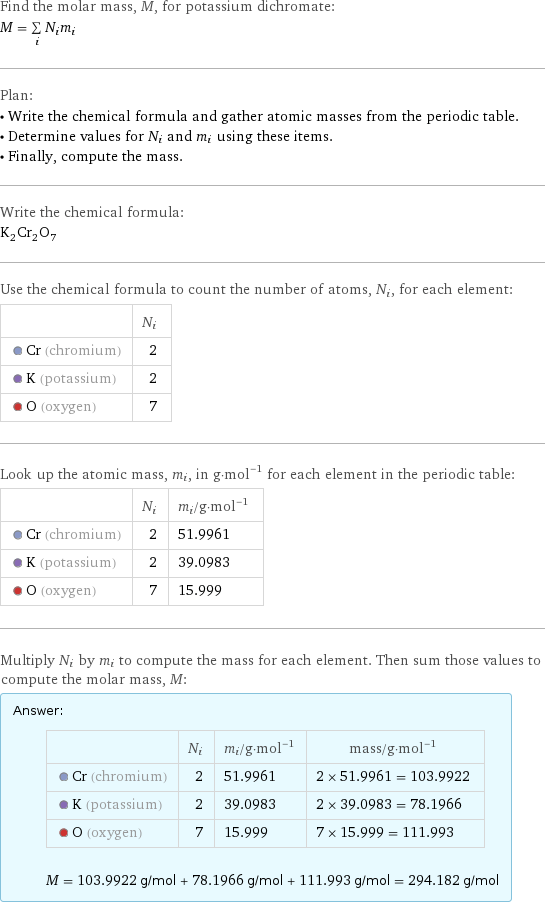Input interpretation

potassium dichromate | molar mass
Result

Find the molar mass, M, for potassium dichromate: M = sum _iN_im_i Plan: • Write the chemical formula and gather atomic masses from the periodic table. • Determine values for N_i and m_i using these items. • Finally, compute the mass. Write the chemical formula: K_2Cr_2O_7 Use the chemical formula to count the number of atoms, N_i, for each element: | N_i Cr (chromium) | 2 K (potassium) | 2 O (oxygen) | 7 Look up the atomic mass, m_i, in g·mol^(-1) for each element in the periodic table: | N_i | m_i/g·mol^(-1) Cr (chromium) | 2 | 51.9961 K (potassium) | 2 | 39.0983 O (oxygen) | 7 | 15.999 Multiply N_i by m_i to compute the mass for each element. Then sum those values to compute the molar mass, M: Answer: | | | N_i | m_i/g·mol^(-1) | mass/g·mol^(-1) Cr (chromium) | 2 | 51.9961 | 2 × 51.9961 = 103.9922 K (potassium) | 2 | 39.0983 | 2 × 39.0983 = 78.1966 O (oxygen) | 7 | 15.999 | 7 × 15.999 = 111.993 M = 103.9922 g/mol + 78.1966 g/mol + 111.993 g/mol = 294.182 g/mol
Unit conversion

0.29418 kg/mol (kilograms per mole)
Comparisons

≈ 0.41 × molar mass of fullerene ( ≈ 721 g/mol )

≈ 1.5 × molar mass of caffeine ( ≈ 194 g/mol )

≈ 5 × molar mass of sodium chloride ( ≈ 58 g/mol )
Corresponding quantities

Mass of a molecule m from m = M/N_A: | 4.9×10^-22 grams | 4.9×10^-25 kg (kilograms) | 294 u (unified atomic mass units) | 294 Da (daltons)

Relative molecular mass M_r from M_r = M_u/M: | 294